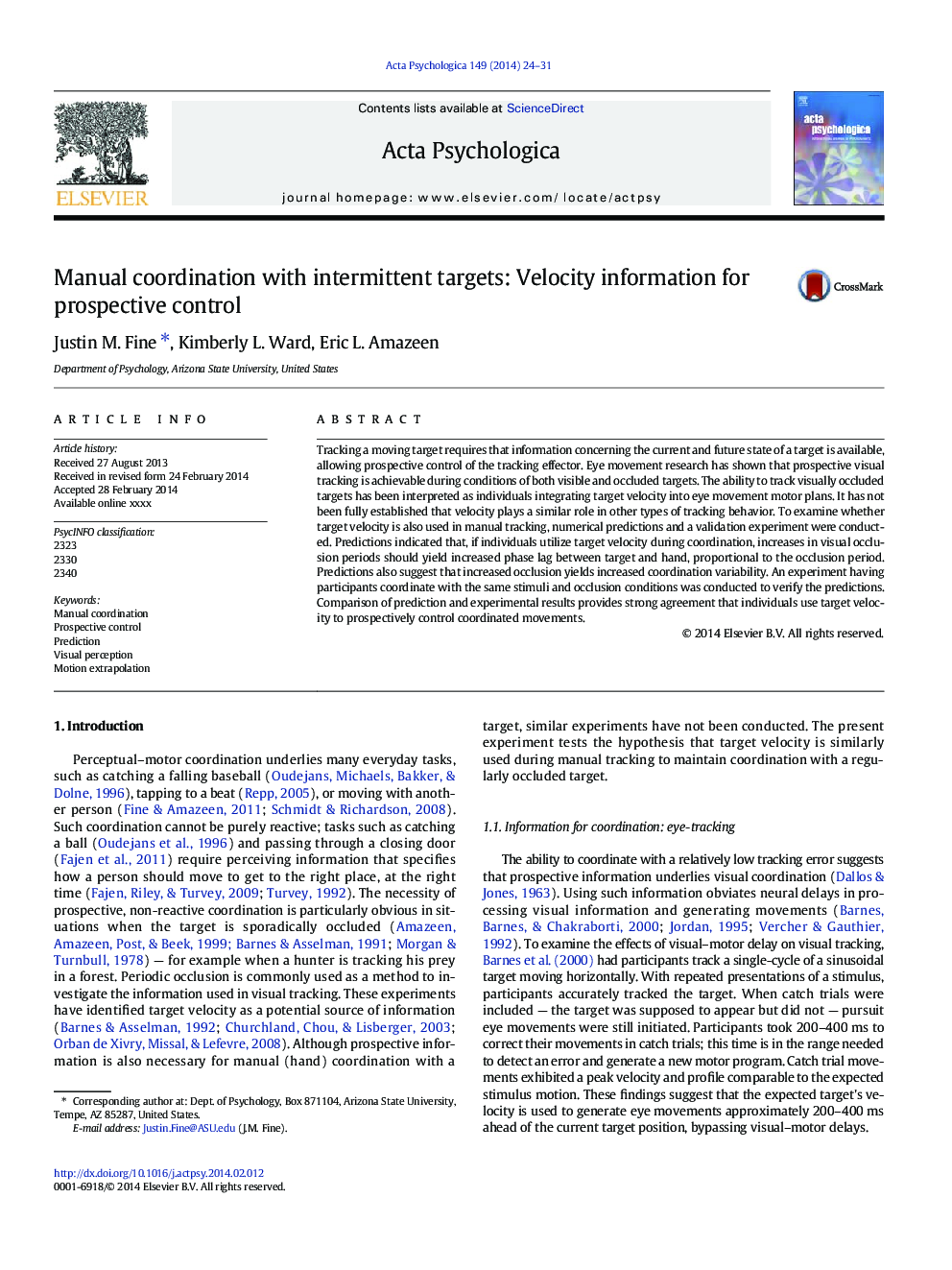| کد مقاله | کد نشریه | سال انتشار | مقاله انگلیسی | نسخه تمام متن |
|---|---|---|---|---|
| 7277639 | 1473609 | 2014 | 8 صفحه PDF | دانلود رایگان |
عنوان انگلیسی مقاله ISI
Manual coordination with intermittent targets: Velocity information for prospective control
ترجمه فارسی عنوان
هماهنگی دستی با اهداف متناوب: اطلاعات سرعت برای کنترل آینده نگر
دانلود مقاله + سفارش ترجمه
دانلود مقاله ISI انگلیسی
رایگان برای ایرانیان
کلمات کلیدی
هماهنگی دستی، کنترل آینده نگر پیش بینی، ادراک بصری، استخراج حرکت، 2323، 2330، 2340،
ترجمه چکیده
ردیابی یک هدف متحرک نیاز به اطلاعاتی در مورد وضعیت فعلی و آینده یک هدف در دسترس است، که امکان کنترل آینده نگر از ردیاب ردیاب را فراهم می کند. تحقیقات جنبش چشم نشان داده است که ردیابی بینایی چشمگیر در شرایط هر دو هدف قابل مشاهده و انعطاف پذیر قابل دستیابی است. توانایی ردیابی اهداف چشمگیر چشمگیر به عنوان افرادی که سرعت هدف را به برنامه های حرکتی حرکت چشم متصل می کنند تفسیر شده است. به طور کامل ثابت نشده است که سرعت نقش مشابهی را در سایر انواع رفتار ردیابی ایفا می کند. برای بررسی اینکه آیا سرعت هدف نیز در ردیابی دستی استفاده می شود، پیش بینی های عددی و آزمایش اعتبار سنجی انجام شده است. پیش بینی ها نشان داد اگر افراد از سرعت هدف در طول هماهنگی استفاده کنند، افزایش در دوره های انسداد بینایی باید منجر به افزایش فاصله فاز بین هدف و دست، متناسب با دوره انسداد شود. پیش بینی ها نیز نشان می دهد افزایش انسداد باعث افزایش تغییرات هماهنگی می شود. یک آزمایش که شرکت کنندگان را با یک محرک و شرایط انعقادی هماهنگ می کند، برای بررسی پیش بینی ها انجام شد. مقایسه پیش بینی ها و نتایج تجربی، توافق شدیدی را نشان می دهد که افراد از سرعت هدف استفاده می کنند تا به طور چشمگیری کنترل حرکت های هماهنگ را کنترل کنند.
موضوعات مرتبط
علوم زیستی و بیوفناوری
علم عصب شناسی
علوم اعصاب شناختی
چکیده انگلیسی
Tracking a moving target requires that information concerning the current and future state of a target is available, allowing prospective control of the tracking effector. Eye movement research has shown that prospective visual tracking is achievable during conditions of both visible and occluded targets. The ability to track visually occluded targets has been interpreted as individuals integrating target velocity into eye movement motor plans. It has not been fully established that velocity plays a similar role in other types of tracking behavior. To examine whether target velocity is also used in manual tracking, numerical predictions and a validation experiment were conducted. Predictions indicated that, if individuals utilize target velocity during coordination, increases in visual occlusion periods should yield increased phase lag between target and hand, proportional to the occlusion period. Predictions also suggest that increased occlusion yields increased coordination variability. An experiment having participants coordinate with the same stimuli and occlusion conditions was conducted to verify the predictions. Comparison of prediction and experimental results provides strong agreement that individuals use target velocity to prospectively control coordinated movements.
ناشر
Database: Elsevier - ScienceDirect (ساینس دایرکت)
Journal: Acta Psychologica - Volume 149, June 2014, Pages 24-31
Journal: Acta Psychologica - Volume 149, June 2014, Pages 24-31
نویسندگان
Justin M. Fine, Kimberly L. Ward, Eric L. Amazeen,
